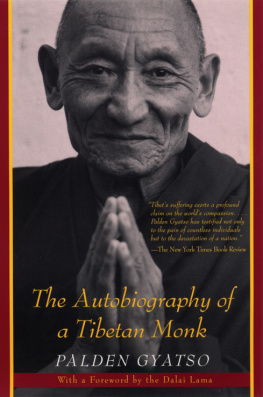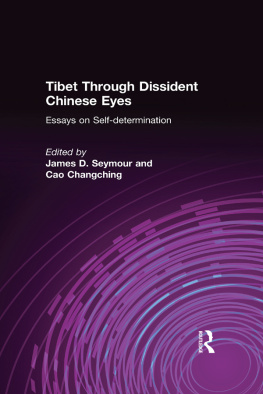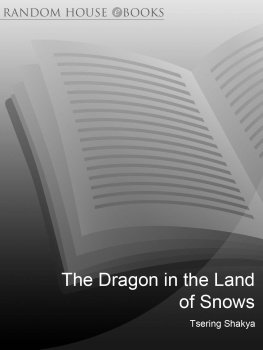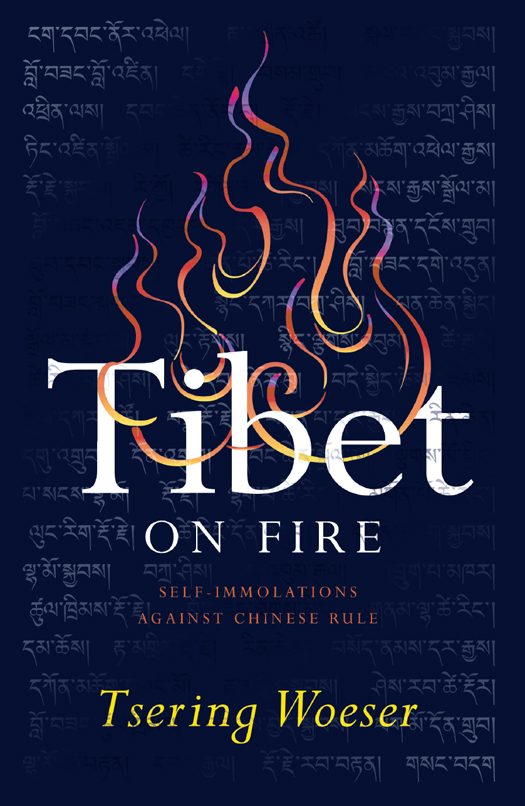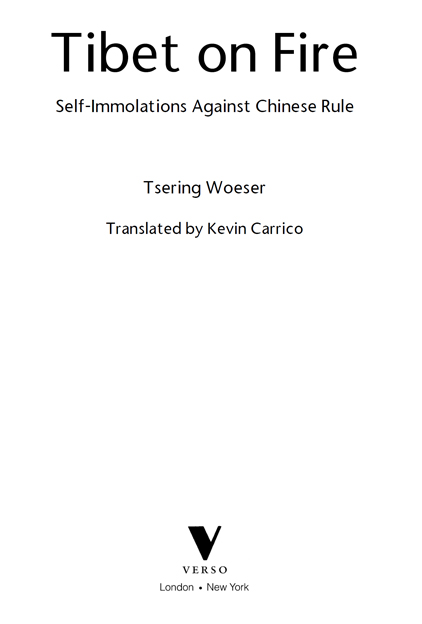The translator would like to thank Stanford Universitys Center for East Asian Studies, where this translation was completed, and Paul Mooney, who generously read and commented on initial drafts.
First published in the English language by Verso 2016
Translation Kevin Carrico 2016
Originally published as Immolations au Tibet: La honte du monde
Indigne ditions 2013
All rights reserved
The moral rights of the author have been asserted
Verso
UK: 6 Meard Street, London W1F 0EG
US: 20 Jay Street, Suite 1010, Brooklyn, NY 11201
versobooks.com
Verso is the imprint of New Left Books
ISBN-13: 978-1-78478-153-8 (PB)
eISBN-13: 978-1-78478-155-2 (US)
eISBN-13: 978-1-78478-154-5 (UK)
British Library Cataloguing in Publication Data
A catalogue record for this book is available from the British Library
Library of Congress Cataloging-in-Publication Data
Woeser, 1966 author.
[Immolations au Tibet. English]
Tibet on fire : self-immolations against Chinese rule / Tsering Woeser; translated by Kevin Carrico.
pages cm
Originally published as Immolations au Tibet : la honte du monde, Indigene editions 2013.
Includes bibliographical references.
ISBN 978-1-78478-153-8 (pbk. : alk. paper)
1. Self-immolationPolitical aspectsChinaTibet Autonomous Region. 2. Self-immolationPolitical aspectsChina. 3. Self-immolationReligious aspectsBuddhism. 4. Tibet Autonomous Region (China)HistoryAutonomy and independence movements. 5. Tibet Autonomous Region (China)Politics and government1951 I. Title.
HV6548.C52T538713 2016
362.2809515dc23
2015028004
v3.1
Contents
Acknowledgments
T ibet on Fire is dedicated to all of the Tibetans who have self-immolated over the past six years.
Although this book is not long, the two months that I spent writing it were both mentally and physically exhausting. And there is only one reason for the overwhelming rush of emotions that I felt in the process of writing: 146 fellow Tibetans have sacrificed their lives to these flames of protest, and no words in this world could ever even begin to fully live up to this act.
This book is my attempt to analyze and understand these acts of self-immolation. It is furthermore a critique: a critique of the Chinese Communist authorities and their wanton exercise of power, as well as a critique of the global community, which has shown itself to be far too willing to compromise with this power. As Ai Weiwei once commented on Twitter, Tibet is the most serious test for todays China and for the international communitys standards of human rights and justice. There is no dodging this test, and there is no getting around it. And thus far, everyone should be disgraced and ashamed at the results.
I would like to express my thanks to this books translator, Kevin Carrico. I would also like to thank Audrea Lim, our editor, for her thought-provoking feedback and guidance throughout this process.
Tsering Woeser
August 5, 2015, Beijing
Prologue
F ebruary 27, 2009, was the third day of Losar, the Tibetan New Year. It was also the day that self-immolation came to Tibet. The authorities had just cancelled a Great Prayer Festival (Monlam) to commemorate the victims of the government crackdown in 2008. A monk by the name of Tapey stepped out of the Kirti Monastery and set his body alight on the streets of Ngawa, in the region known in Tibetan as Amdo, a place of great religious reverence and relevance, now designated as part of Chinas Sichuan Province. Losar is usually a celebratory festival, but it was marked by the majority of Tibetans in 2009 in silent mourninga mourning that continues to this day. On account of the unrelenting government suppression that followed in the wake of protests across Tibet the year before, a slogan has spread secretly among the people of Tibet: No Losar. Tibetans had decided not to celebrate Losar, as a means of resisting Chinese rule. And continuing this resistance, Tapeys final act would become the beginning of a series of self-immolations that have spread across Tibet and beyond in recent years.
What happened in 2008? On March 14, just a few months before the Olympic Games in Beijing, riots broke out in Lhasa in response to the violent suppression by Chinese security forces of monks peaceful protests four days earlier. This bloody day has come to be known as the Ngawa Massacre.
Nearly a year later, this violence was unleashed again against the victims, as the authorities blocked an annual commemorative prayer festival in their honor. Before his final act, Tapey left a note declaring that this decision left him with no choice but to set his body alight in protest. clearly show Tapey lying on the ground surrounded by sixteen uniformed and plainclothes police officers, at least three of whom are armed with guns, while another nearby menacingly brandishes a baton.
Monks from Tapeys monastery report that gunshot wounds to his right arm and legs left him crippled.
S ince that day in February 2009 when the flames of protest were first lit in Tibet, I have documented every act of self-immolation and shared this information on my blog. I have provided daily updates, just as I first chronicled the protest movement of 2008. This book has grown out of my blog, and in both places I have chosen not to provide the names of many of the people I have quoted, for fear of threatening their safety.
Back in February of 2009, as I read about Tapeys final act, I never could have imagined that so many Tibetans would sacrifice their bodies and lives to these flames, in a series of protests unlike any that the world has ever seen. And I certainly never could have predicted that my blogging would barely be able to keep pace with the lives sacrificed for this cause. In Ngawa alone, thirty-nine more people have followed in Tapeys footsteps. At least ten Tibetans have given themselves to the flames on the same street where Tapey self-immolated; it is now known among Tibetans as Heroes Lane. As of July 9, 2015, 146 Tibetans have chosen the path of self-immolation. This is unprecedented in human history.
The Chinese government has declared self-immolation a crime, thus making those who commit this act criminals. And the state has furthermore unveiled an ambitious campaign against self-immolation that extends throughout Tibetan areas of the country. One aspect of this campaign has been collective punishment of the Tibetan community, including the arrest and sentencing of relatives, friends, and neighbors of self-immolators. Another has been a resolute blockade on any and all information related to instances of self-immolation. In this environment, news of such incidents only manages to find its way out of Tibet days, weeks, or even months after the fact. And because of this information blockade, the real number of self-immolations may be But because no further information has yet emerged on this case, I am unable to confirm it, and it is not included in the 146 cases.
The details recounted in this book, which aims to provide a general overview of the wave of self-immolations thus far, are based solely upon fully verified and publicly available information, much of which can be found on the Internet.driver, a retired government cadre, a laundry owner, a park ranger, and three activists exiled abroad. All are Tibetan.


